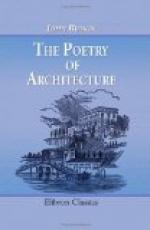[Footnote 39: The epithet “raw,” by the by, is vague, and needs definition. Every tint is raw which is perfectly opaque, and has not all the three primitive colors in its composition. Thus, black is always raw, because it has no color; white never, because it has all colors. No tint can be raw which is not opaque; and opacity may be taken away, either by actual depth and transparency, as in the sky; by luster and texture, as in the case of silk and velvet, or by variety of shade as in forest verdure. Two instances will be sufficient to prove the truth of this. Brick, when first fired, is always raw; but when it has been a little weathered, it acquires a slight blue tint, assisted by the gray of the mortar: incipient vegetation affords it the yellow. It thus obtains an admixture of the three colors, and is raw no longer. An old woman’s red cloak, though glaring, is never raw; for it must of necessity have folded shades: those shades are of a rich gray; no gray can exist without yellow and blue. We have then three colors, and no rawness. It must be observed however, that when any one of the colors is given in so slight a degree that it can be overpowered by certain effects of light, the united color, when opaque, will be raw. Thus many flesh-colors are raw; because, though they must have a little blue in their composition, it is too little to be efficiently visible in a strong light.]
203. For the rest, it is always to be kept in view, that the prevailing character of the whole is to be that of graceful simplicity; distinguished from the simplicity of the Italian edifice, by being that of utility instead of that of pride.[40] Consequently the building must not be Gothic or Elizabethan: it may be as commonplace as the proprietor likes, provided its proportions be good; but nothing can ever excuse one acute angle, or one decorated pinnacle,—both being direct interruption of the repose with which the eye is indulged by the undulations of the surrounding scenery. Tower and fortress outlines are indeed agreeable, for their fine grouping and roundness; but we do not allude to them, because nothing can be more absurd than the humor prevailing at the present day among many of our peaceable old gentlemen, who never smelt powder in their lives, to eat their morning muffin in a savage-looking round tower, and admit quiet old ladies to a tea-party under the range of twenty-six cannon, which—it is lucky for the china—are all wooden ones,—as they are, in all probability, accurately and awfully pointed into the drawing-room windows.




